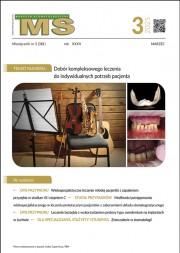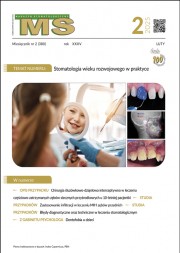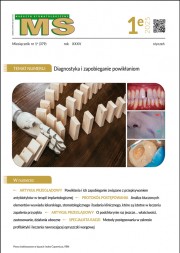Dostęp do tego artykułu jest płatny.
Zapraszamy do zakupu!
Po dokonaniu zakupu artykuł w postaci pliku PDF prześlemy bezpośrednio pod twój adres e-mail.
ARTYKUŁ PRZEGLĄDOWY
O podchlorynie sodu raz jeszcze ….
About sodium hypochlorite once again….
Mariusz Lipski
Piśmiennictwo
1. Lipski M. Podchloryn sodu w leczeniu endodontycznym. Mag. Stomatol., 1994; 4, 1, 14-16.
2. Cai C, Chen X, Li Y, Jiang Q. Advances in the role of sodium hypochlorite irrigant in chemical preparation of root canal treatment. Biomed. Res. Int., 2023; 13, 2023:8858283.
3. Wujec , Pawlicka H. Standardowe środki płuczące polecane w leczeniu endodontycznym. Dent. Med. Probl., 2008; 45, 4, 466-472.
4. Demenech LS, Tomazinho FSF, Baratto-Filho F i wsp. Biocompatibility of the 8.25% sodium hypochlorite irrigant solution in endodontics: An in vivo study. Microsc Res Tech. 2022; 84(7):1506-1512.
5. Vitali FC, Santos PS, Garcia LDFR, Teixeira CDS. Postoperative pain after endodontic treatment using 8.25% vs 2.5% sodium hypochlorite in necrotic mandibular molars with apical periodontitis: A randomized double-blind clinical trial. J Am Dent Assoc. 2024; 155(8):657-666.
6. Demenech LS, de Freitas JV, Tomazinho FSF i wsp. Postoperative Pain after Endodontic Treatment under Irrigation with 8.25% Sodium Hypochlorite and Other Solutions: A Randomized Clinical Trial. J Endod. 2021;47(5):696-704.
7. Cullen JK, Wealleans JA, Kirkpatrick TC, Yaccino JM. The effect of 8.25% sodium hypochlorite on dental pulp dissolution and dentin flexural strength and modulus. J Endod. 2015;41(6):920-4.
8. Wang Z, Shen Y, Haapasalo M. Dynamics of dissolution, killing, and inhibition of dental plaque biofilm. Front. in Microbiol., 2020; 11, 964.
9. Du T , Wang Z, Shen Y i wsp. Effect of long-term exposure to endodontic disinfecting solutions on young and old Enterococcus faecalis biofilms in dentin canals. J. Endod., 2014; 40, 4, 509–514.
10. Xu J, Gao Y, Meng Y. Mechano-chemical coupling of irrigation enhances endodontic biofilm debridement. Biofouling, 2020; 36, 7, 792–799.
11. Sasanakul P, Ampornaramveth RS, Chivatxaranukul P. Influence of adjuncts to irrigation in the disinfection of large root canals. J. Endod., 2019; 45, 3, 332–337.
12. Cvek M, Nord M, Hollender L. Antimicrobial effect of root canal debridgement in teeth with immature root. A clinical and microbiologic study. Odontol. Rev., 1976; 27, 1, 1–10.
13. Hand RE, Smith ML, Harrison JW. Analysis of the effect of dilution on the necrotic tissue dissolution property of sodium hypochlorite. J. Endod., 1978; 4, 1, 60–64.
14. Duncan HF, Kirkevang LL, Peters OA i wsp. Treatment of pulpal and apical disease: The European Society of Endodontology (ESE) S3-level clinical practice guideline. Int. Endod. J., 2023; 56 Suppl. 3, 238-295.
15 Endodoncja wieku dojrzałego i rozwojowego autorstwa Marii Barańskiej-Gachowskiej, red. Mariusz Lipski, Wyd. 3, Czelej, Lublin 2022.
16. Wszystko o podchlorynie sodowym (NaOCl) http://endodoncja.pl/old/opracowanie2.html
17. Radcliffe C E, Potouridou L, Qureshi R. Antimicrobial activity of varying concentrations of sodium hypochlorite on the endodontic microorganisms Actinomyces israelii, A. naeslundii, Candida albicans and Enterococcus faecalis. Int. Endod. J., 2004; 37, 7, 438– 446.
18. Petridis X, Busanello FH, Dijkstra RJB i wsp. Factors affecting the chemical efficacy of 2% sodium hypochlorite against oral steady-state dual-species biofilms: exposure time and volume application,” Int. Endod. J., 2019; 52, 8, 1182–1195, 2019.
19. Pereira TC, Dijkstra RJB, Petridis X i wsp. The influence of time and irrigant refreshment on biofilm removal from lateral morphological features of simulated root canals. Int. Endod. J., 2020; 53, 12, 1705–1714.
20. Zehnder M. Root canal irrigants. J. Endod., 2006; 52, 5, 389–398.
21. Macedo R G, Verhaagen V, Wesselink P i wsp. Influence of refreshment/activation cycles and temperature rise on the reaction rate of sodium hypochlorite with bovine dentine during ultrasonic activated irrigation. Int. Endod. J., 2014; 47, 2, 147–154.
22. Velvart P. Beständigkeit von Natriumhypochlorite zur Wurzelkanalspüllung. Schweiz. Monatschr. Zahnmed., 1987; 97, 12, 1509-1512.
23. Zou L, Shen Y, Li W, Haapasalo M. Penetration of sodium hypochlorite into dentin. J. Endod., 2010; 36, 5, 793–796.
24. Faria G, Viola KS, Coaguila-Llerena H. Penetration of sodium hypochlorite into root canal dentine: effect of surfactants, gel form and passive ultrasonic irrigation. Int. Endod. J., 2019; 52, 3, 385–392.
25. Adıgüzel Ö, Bshara NS, Al Nesser ST. Antibacterial effect of sodium hypochlorite gel on Enterococcus faecalis in endodontics: a systematic review. Int. Endod., J., 2020; 10, 1, 22–29.
26. Giardino L, Ambu E, Becce C. Surface tension comparison of four common root canal irrigants and two new irrigants containing antibiotic. J. Endod., 2006; 32, 11, 1091–1093.
27. Coaguila-Llerena H, Barbieri L, Tanomaru-Filho M i wsp. Physicochemical properties, cytotoxicity and penetration into dentinal tubules of sodium hypochlorite with and without surfactants,” Rest. Dent. Endod., 2020; 45, 4, e47.
28. Palazzi F, Blasi A, Mohammadi Z i wsp. Penetration of sodium hypochlorite modified with surfactants into root canal dentin. Braz. Dent. J., 2016; 27, 2, 208–216.
29. Tonini R, Salvadori M, Audino E i wsp. Irrigating Solutions and Activation Methods Used in Clinical Endodontics: A Systematic Review. Front. Oral Health, 2022; 31, 3:838043.
30. Tanomaru-Filho M, Miano LM, Chávez-Andrade GM i wsp. Cleaning of Root Canal System by Different Irrigation Methods. J. Contemp. Dent. Pract., 2015; 1;16, 11, 859-863.
31. Duncan HF, Galler KM, Tomson PL I wsp. European Society of Endodontology position statement: Management of deep caries and the exposed pulp. Int. Endod. J., 2019; 52, 7, 923-934.
32. AAE Position Statement on Vital Pulp Therapy. J. Endod., 2021; 47, 9, 1340-1344
33. Guldener PA, Langeland K. Endodontologia, Diagnostyka i leczenie chorób miazgi i ozębnej. Warszawa, PZWL 2002.
34. Gatot A, Arbelle J, Leiberman A, Yanai-Inbar I. Effects of sodium hypochlorite on soft tissues after its inadvertent injection beyond the root apex. J. Endod., 1991; 17, 11, 573-574.
35 Gursoy UK, Bostanci V, Kosger HH. Palatal mucosa necrosis because of accidental sodium hypochlorite injection instead of anaesthetic solution. Int. Endod. J. 2006; 3, 2, 157-161.
36 Hryniewiecka L, Wesołowski P, Tuderek-Sobocińska G, Wojtowicz A. Complications arising from the incorrect use of sodium hypochlorite. Description of clinical cases. Czas. Stomatol., 2013; 66, 2, 270-280.
37. Serper A, Özbek M, Çalt S. Accidental sodium hypochlorite-induced skin injury during endodontic treatment. J. Endod., 2004; 30, 3, 180-181.
38. Ingram 3rd TA.: Response of the human eye to accidental exposure to sodium hypochlorite. J. Endod., 1990; 16, 5, 235-238.
39. Prado M, Santos Júnior HM, Rezende CM i wsp. Interactions between irrigants commonly used in endodontic practice: a chemical analysis. J Endod. 2013; Apr;39(4):505-10.
40. Thaha KA, Varma RL, Nair MG i wsp. Interaction between octenidine-based solution and sodium hypochlorite: a mass spectroscopy, proton nuclear magnetic resonance, and scanning electron microscopy-based observational study. J. Endod., 2017; 43, 1, 135–140
41. Coaguila-Llerena H, Rodrigues H, Santos CS. Effects of octenidine applied alone or mixed with sodium hypochlorite on eukaryotic cells. Int. Endod. J., 2020; 53, 9, 1264–1274.
42. Kaiser S, Kramer M, Thiel C. Severe complications after non-intended usage of octenidine dihydrochloride. A case series with four dogs. Tierarztl. Prax. Ausg., Kleintiere Heimtiere, 2015; 43, 5, 291-298.
43. Lima Nogueira BM, da Costa Pereira TI, Pedrinha VP, de Almeida Rodrigues P. Effects of different irrigation solutions and protocols on mineral content and ultrastructure of root canal dentine. Iran. Endod. J., 2018; 13, 2, 209–215.
44. Rath PP, Yiu CKY, Matinlinna JP i wsp. The effect of root canal irrigants on dentin: a focused review Rest. Dent. Endod., 2020; 45, 3, e39.
45. Qian W, Shen Y, Haapasalo M. Quantitative analysis of the effect of irrigant solution sequences on dentin erosion. J. Endod., 2011; 37, 10, 1437-1441.















